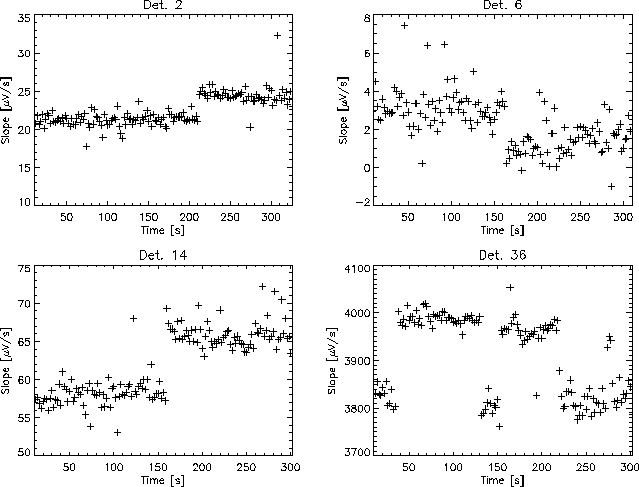Detector jumps are another feature seen in the detector responsivities
apparently similar to glitches. For unknown reasons the signal level
seems to jump, mostly up and then decaying, but also sometimes down.
Jumps can be as high as 10 ![]() V/s. They affect the zero level of
the detector(s) and therewith dark current subtraction. They occur about
once per 5 hours per detector. For low flux observations at high gain
they are a big nuisance. In band 1 and 2 about half of the jumps are
associated with glitches. However, no correlation has been found
between the characteristics of these jumps and those of the
glitches.
V/s. They affect the zero level of
the detector(s) and therewith dark current subtraction. They occur about
once per 5 hours per detector. For low flux observations at high gain
they are a big nuisance. In band 1 and 2 about half of the jumps are
associated with glitches. However, no correlation has been found
between the characteristics of these jumps and those of the
glitches.
Part of the jumps are due to sudden changes in the pulse-shape correction. The change can be either in amplitude or in decay time or in both. Why the pulse-shape is suddenly changing is unclear. Since the introduction of pulse-shape correction (Section 7.2.6) in OLP 10, the jumps have lost some of their acuity although they are still present.
Detector jumps come in two different kinds. Either a single detector jumps or the complete detector block jumps.
The document by Heras 1997, [13] summarizes a study made on
single detector signal jumps. These effects occur in only one detector
at a time and can be generally described as a sudden increase or
decrease of the signal, which then remains constant or has a long
recovering time (![]() 10 s) after the jump. These jumps are normally
seen at low signal levels. Examples of such jumps in SPD data are shown
in Figure 9.8
10 s) after the jump. These jumps are normally
seen at low signal levels. Examples of such jumps in SPD data are shown
in Figure 9.8

|
The signal jumps observed for each detector vary significantly between different cases, and may be negative or positive.
Jumps in band 3 are of different nature from jumps in bands 1 and 2. In band 3 it sometimes has the character op popcorn-noise, jumping up and down between two more or less fixed levels. This popcorn-noise is associated with `popping' pulse-shape corrections.
Users are recommended to examine the SPD from their observations to look for such jumps. If they are present the user can either throw the affected portions of the data away or try to adjust the baseline of the affected portion to the pre- and post-jump baseline.
The symptoms are that each detector in a block suffers a sudden rise in sensitivity, which slowly decays with time. They usually only affect one of an up-down scan pair, and the only solution is to throw the affected scan portion away. As they affect an entire detector block they are given the name `scan jumps'.